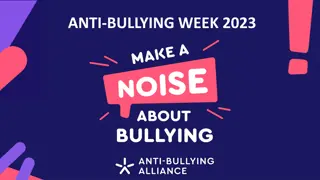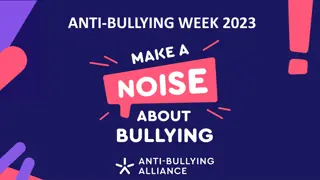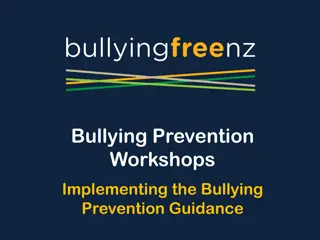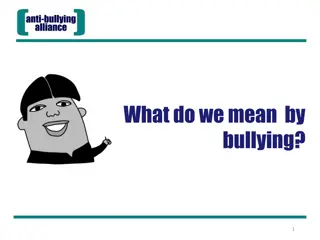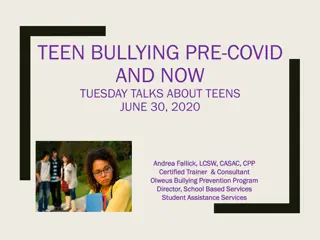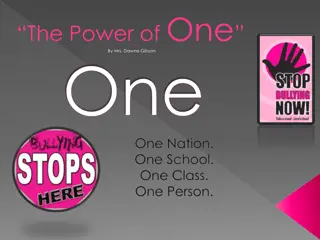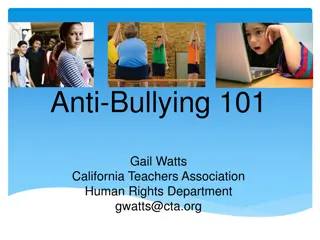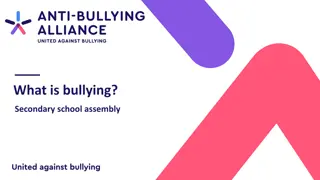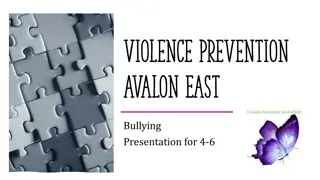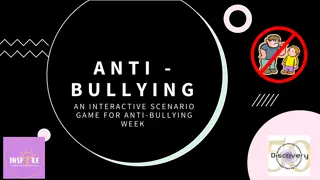Bullying: Key Points and Types
Delve into the essential aspects of bullying with key points on what bullying entails, how to recognize it, bullyproofing strategies for children, and seeking help when needed. Explore the different types of bullying including physical, verbal, indirect, and cyberbullying. Differentiate bullying from teasing and conflict, understand where and when bullying commonly occurs, and grasp the gender differences in bullying behaviors between boys and girls.
Uploaded on Sep 07, 2024 | 1 Views
Download Presentation

Please find below an Image/Link to download the presentation.
The content on the website is provided AS IS for your information and personal use only. It may not be sold, licensed, or shared on other websites without obtaining consent from the author.If you encounter any issues during the download, it is possible that the publisher has removed the file from their server.
You are allowed to download the files provided on this website for personal or commercial use, subject to the condition that they are used lawfully. All files are the property of their respective owners.
The content on the website is provided AS IS for your information and personal use only. It may not be sold, licensed, or shared on other websites without obtaining consent from the author.
E N D
Presentation Transcript
Adapted from presentation presented by Alberti Center For Bullying Abuse Prevention , 2014
KEY POINTS OF PRESENTATION WHAT IS BULLYING? RECOGNIZE THE WARNING SIGNS BULLYPROOFING YOUR CHILD MY CHILD IS BEING BULLIED MY CHILD MIGHT BE BULLYING OTHERS HOW DO I GET HELP?
WHAT IS BULLYING? INTENTIONAL, USUALLY REPEATED ACTS OF VERBAL, PHYSICAL, OR WRITTEN AGGRESSION BY A PEERS (OR GROUP OF PEERS) OPERATING FROM A POSITION OF STRENGTH OR POWER WITH THE GOAL OF HURTING THE VICTIM PHYSICALLY OR DAMAGING STATUS AND/OR SOCIAL REPUTATION OLWEUS (1978; UNITED STATES DEPARTMENT OF EDUCATION (1989)
WHAT ARE THE DIFFERENT TYPES OF BULLYING? Physical bullying *Punching, shoving, acts that hurt people Verbal bullying *Name calling, making offensive remarks Indirect bullying *Spreading rumors, excluding, ganging up Cyber bullying *Sending insulting messages, pictures or threats by email, text messaging, chat rooms Hinduja & Patchin (2009)
HOW IS BULLYING DIFFERENT FROM TEASING AND CONFLICT? Bullying: Based on a power imbalance; intent to cause psychological harm; usually repeated Teasing: fun, good-natured, give- and-take between friends to get both parties to laugh Conflict: A struggle, dispute, or misunderstanding between two equal forces
WHEN AND WHERE DOES BULLYING OCCUR? PRE K THROUGH LATE HIGH SCHOOL (AND BEYOND); PEAKS IN GRADES 4-7 CAN HAPPEN ANYWHERE, BUT IT IS MORE LIKELY TO OCCUR IN LESS CLOSELY SUPERVISED AREAS (BUS, LOCKER ROOM, HALLWAYS, PLAYGROUND, ONLINE)
IS BULLYING DIFFERENT IN BOYS AND GIRLS? BOYS GIRLS *More direct, physical bullying *Bully more frequently than girls *Bully both girls and boys *More indirect (harder to detect) *Often occurs in groups with girls of same age *Cyberbullying slightly more common that for males Hinduja & Patchin (2009)
WHAT WE KNOW ABOUT STUDENTS WHO BULLY? Desire for power Get satisfaction from others suffering Justify their behavior ( he deserved it ) More exposed to physical punishment More likely to be depressed May have other problem behaviors (alcohol and drug use, fighting) Olweus (2003)
WARNING SIGNS THAT YOUR CHILD MAY BE A BULLY *Refer to others negatively *Lack empathy *Strong need to get his/her own way *Hostile/defiant attitude *Angers easily *Deny involvement or blame others when behavior is addressed CONSEQUENCES OF BEING A BULLY More likely to experience legal or criminal troubles as adults Poor ability to develop and maintain positive relationships
CHARACTERSITICS OF CHILDREN WHO ARE BULLIED HAVE A POSITION OF RELATIVE WEAKNESS *Age, ethnic background, financial status, disability, sexual orientation MOST ARE PASSIVE AND LACK ASSERTIVENESS *Do nothing to invite aggression *Do not fight back when attacked *May relate better to adults than peers SOME PROVOKE OTHERS *Offend, irritate, tease others *reactive; fight bask when attacked Olweus (1978)
WHAT ARE CHILDREN BULLIED ABOUT? APPEARANCE PERCEIVED SEXUAL ORIENATION HOW MASCULIN OR FEMANINE THEY APPEAR ABILITY AT SCHOOL ( invisible disabilities) RACE/ETHNICITY MONEY RELIGION
WARNING SIGNS THAT A CHILD MAY BE BULLIED UNEXPLAINED ILLNESSES, CUTS/BRUISES NOT WANTING TO GO TO SCHOOL OR BE IN SOCIAL SITUATIONS ANY CHANGE IN BEHAVIOR *No interest in doing things that he/she used to enjoy *Withdrawn CONSEQUENCES OF BEING BULLIED EMOTIONAL DISTRESS LONLINESS, PEER REJECTION INCREASED ANXIETY, DEPRESSION, SUICIDAL IDEATION MAY RESPOND WITH EXTREME VIOLENCE IN SOME CASES
BULLYPROOFING YOUR CHILD BE A POSITIVE ROLE MODEL *Talk with and listen to your child (about school, peers, interests) *Listen to and validate concerns about friends and other students *Treat other with dignity and respect *Avoid using derogatory terms toward or about others in person and/or electronically Hinduja & Patchin (2009)
BULLYPROOFING YOUR CHILD GET AND STAY INVOLVED *Get involved in school, community, and at home *Visit school s website and read newsletters *Know the school s policies in terms of bullying prevention and intervention *Attend extracurricular and sporting activities *Join the PTSA and volunteer
BULLYPROOFING YOUR CHILD TEACH CHILDREN GOOD HABITS EARLY AND CONSISTENTLY *Have high expectations for behavior and a low tolerance for being mean *Be specific about how certain words and behaviors can hurt others *Teach better ways to respond *Emphasize the importance of being a friend
TEACH CHILDREN TO BE UPSTANDERS, NOT BYSTANDERS DON T JOIN IN SPEAK UP IF IT IS SAFE TO DO SO BAND TOGTHER AS A GROUP AGAINST BULLIES TELL AN ADULT ABOUT THE BULLY *Tattling/Ratting = telling an adult to get someone in trouble *Telling/Reporting = telling an adult because someone s behavior is unsafe or hurtful to another REACH OUT TO ISOLATED PEERS, OFFER SUPPORT
CYBERBULLYING PREVENTION TEACH RESPONSIBLE USE OF TECHNOLOGY *Only communicate things that you would be ok about your parents seeing *Follow rules (no Facebook under age 13) *Beware of anonymous sites like Formspring *Use the off switch Do not respond to upsetting communications SUPERVISE AND LIMIT ACTIVITIES (NO 24/7) *Have computers in common areas (not bedroom) *Know child s password *Be friend on Facebook *Bring cellphones, computers to parents room to charge overnight
IF YOUR CHILD IS BEING BULLIED LISEN AND EMPATHIZE * Tell me what happened * That must have been very scary for you *Thank child for telling TAKE IT SERIOUSLY *Do not minimalize or trivialize WORK WITH CIHLD TO FIND OUT MORE ABOUT SITUAITON AND PROBLEM-SOLVE *Responses like just ignore it, hit him back, what do you do to bother them? will not help WORK IN PARTNERSHIP WITH THE SCHOOL AND OUTSIDE PROFESSIONALS IF NEEDED FOLLOW-UP
AVAILABLE RESOURCES STUDENTS IN CRISIS *Georgia DOE School Safety Hotline: 1-877-SAY-STOP (1-877-729-7867) *National Suicide Prevention Hotline: 1-800-273-TALK *KnowBully Free Parent App
QUESTIONS/COMMENTS QUESTIONS/COMMENTS Contact Information Dr. Lateasha White: Title I Parent Involvement Liaison Lateasha.White@henry.k12.ga.us
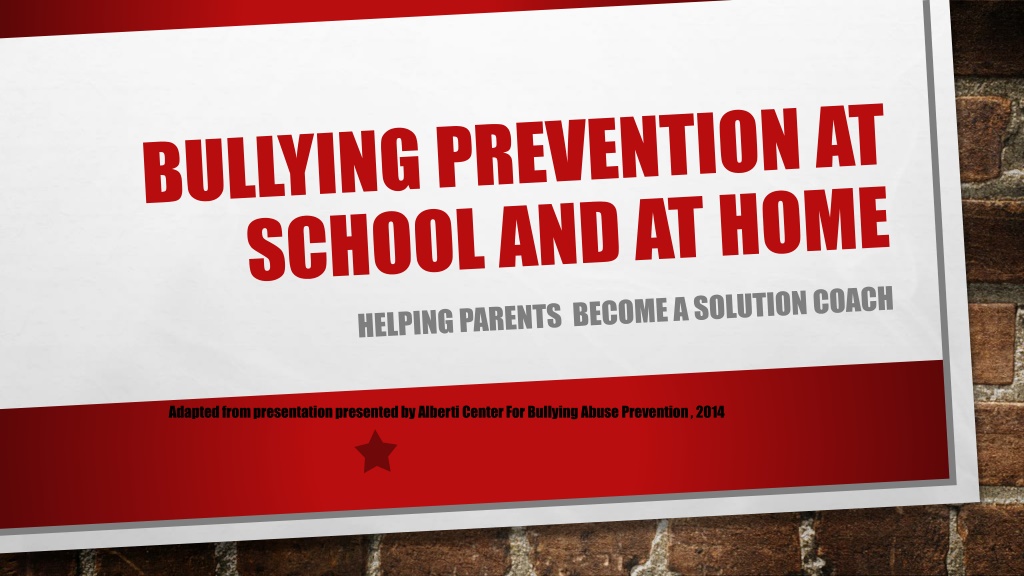
 undefined
undefined





 undefined
undefined

